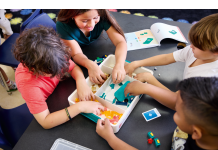John Taylor from Ravensbourne University London discusses the transition from classroom to career, emphasising the need to rethink STEM learning for a more inclusive and hands-on future
Rapid technological advancements and the urgent need for a green transition drive demand for new competencies across all sectors – especially in STEM-related fields.
Nearly 80% of small and medium-sized enterprises in the European Union (EU), however, report difficulty finding workers with skills relevant to computing and artificial intelligence. Education and training have sometimes struggled to adapt, leaving a growing disconnect between the expertise available in the workforce and those required by employers.
Another persistent challenge is the lack of diversity in STEM sectors, especially regarding gender. While women make up 57% of tertiary education students in Europe, only 32.8% are entering STEM fields. At the heart of this problem lies the need to reform how STEM education is delivered – rethinking it not as a pipeline issue, but as an opportunity rooted in the classroom.
By 2030, the European Commission wants Member States to have at least 32% of students enrolled in STEM fields at tertiary level. The figures above underscore the urgency of the workforce challenge and the potential to reshape education in ways that both empower and engage young people.
The power of hands-on learning
Evidence consistently shows experiential, hands-on approaches boost performance and long-term interest in STEM subjects.
Research from Utrecht University highlighted that integrated STEM (iSTEM) education, which blends disciplines through real-world, problem-based learning, boosts both behavioural and emotional engagement by promoting learner autonomy, collaboration, and relevance of content. Students were particularly responsive to lessons that included active problem-solving, teamwork, and decision-making opportunities. Similarly, the Royal Society found that individuals who had participated in STEM work experience were more likely to seek further opportunities compared to those without similar exposure.
Educators can demystify complex scientific concepts and nurture a deeper curiosity by embedding interactive and practical tasks into curricula – such as group experiments, live design challenges, or real-world applications. These approaches build the soft skills essential for today’s collaborative, innovation-driven economy.
Bridging the gender and diversity gap
Disparities in representation don’t just reflect access issues – they signal deeper cultural and pedagogical barriers in how these subjects are taught.
Research has shown that girls often report lower confidence in STEM, which can deter them from pursuing these fields. A 2024 study in Germany also found that female STEM educators reported sexism and gender bias, which may influence how students engage with these subjects.
Inclusive classrooms go beyond representation by adopting gender-sensitive teaching strategies that challenge stereotypes and support diverse learning styles. The European Commission’s report on the gender gap in STEM highlights the importance of incorporating female role models and removing gender bias from educational materials.
By embracing cooperation, creative thinking, and interdisciplinary approaches, educators can make STEM more accessible to underrepresented learners while better reflecting the practical nature of the professions.
To help shift the balance, the EU is launching Girls Go STEM, an initiative to train one million girls and women in related fields by 2028. Delivered through various European programmes, it aims to develop both technical and entrepreneurial skills in key STEM domains.
From policy to practice
Policy-level interventions are essential for systemic change, but their success hinges on widespread classroom implementation.
The European Skills Agenda and the STEM Education Strategic Plan promote inclusive, future-focused learning. The Union of Skills, in particular, emphasises investment in adult development, vocational education and training (VET), and enhanced skills intelligence – key components for building a resilient, adaptable workforce.
Translating these frameworks into practice means investing in teacher training, supporting innovative curricula, and ensuring that all students – regardless of background – can access quality STEM learning from an early age. Educational institutions also play a pivotal role in linking policy to lived experiences through local partnerships, work-based learning, and interdisciplinary research.
Lifelong learning and workforce readiness
While nearly half (47%) of adults in the EU engaged in some form of learning in 2022, significant gaps remain – especially when it comes to being STEM-ready.
As automation and digital innovation continue to reshape industries, employers urgently seek talent with adaptable, future-facing skillsets. This makes the case for more flexible and accessible upskilling pathways beyond traditional education models.
Vocational education, digital skills bootcamps, and modular university courses offer promising solutions, notably when developed in partnership with employers and local communities. The EU must position lifelong learning as a shared responsibility between education systems, industries, and governments to future-proof the workforce.
Designing a future where STEM is for everyone
STEM education shouldn’t aim to merely select the few who ‘fit’, but to equip the many to thrive. A more inclusive, hands-on approach can unlock the full potential of Europe’s talent and build a workforce equipped for the challenges of the fourth industrial revolution.
The challenge ahead is not just to deliver STEM education, but to reimagine how – and for whom – we teach it.











